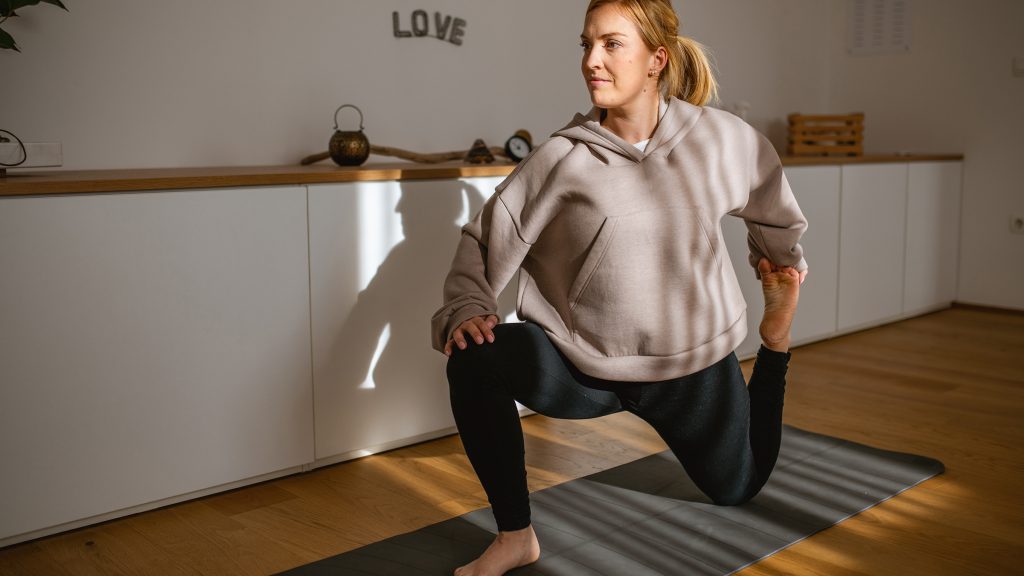Rise & Stretch: Start Your Morning Safely to Prevent Back Pain

Image from: https://stretch22.com/the-top-5-stretching-exercises-for-flexibility/
Waking up stiff or sore in your back or shoulders is a familiar experience for many. But a few targeted, gentle stretches first thing can help “wake up” tissues, promote blood flow, reduce stiffness, and prime your spine and surrounding muscles for the day. When done wisely, this morning routine can also help reduce your risk of back and shoulder injuries over time.
In this article, we’ll cover:
- Some of the best stretches to begin your day (especially for your back, hips, and shoulders)
- Guidelines on how far to push when stretching if you’re feeling soreness
- Whether it is ever OK to continue stretching when you have moderate pain, or whether to stop
- Tips for safely integrating stretching into your routine
Best Morning Stretches for Back and Shoulder Health
Here are some gentle, effective stretches you can do before getting out of bed or right after rising, then continue as you get up. Always move slowly and with awareness.
Sample Morning Stretches
Below are stretches commonly recommended by physiotherapists and health sources. Always tailor them to your body’s condition (e.g. avoid ones that aggravate you).
Knee-to-Chest Stretch
Purpose: Helps release tension in lower back, hips
How to Do it: Lie on your back, knees bent. Gently pull one (or both) knees toward your chest.
Hold / Repetitions / Notes: Hold ~ 20–30 seconds, 2–3 reps each side. [Mayo Clinic, Nuffield Health]
Lower Back Rotation / Supine Twist
Purpose: Mobilises lumbar spine, eases stiffness
How to Do it: Lie on your back, knees bent, drop knees to one side while keeping shoulders flat.
Hold / Repetitions / Notes: Hold ~ 20–30 sec per side. [Mayo Clinic, Nuffield Health]
Cat–Cow / Spinal Flexion-Extension (on all fours or standing)
Purpose: Mobilises thoracic and lumbar spine
How to Do it: Move between arched back (cow) and rounded back (cat), or variants upright
Hold / Repetitions / Notes: Several slow repeats, breathing with movement. [Verywell Health]
Child’s Pose / Extended Child’s Stretch
Purpose: Gently lengthens lower back, hips
How to Do it: From kneeling, sit back toward heels, reach arms forward, forehead to floor
Hold / Repetitions / Notes: Hold ~ 20–30 sec, maybe repeat. [Verywell Health]
Thoracic Spine / Upper Back Stretch (e.g. “open book” or spinal extension over roll)
Purpose: Helps counteract upper back stiffness from sitting / slouching
How to Do it: Lie sideways, support top arm on floor and rotate torso, or lie over a rolled towel under thoracic spine and gently extend
Hold / Repetitions / Notes: Hold ~15–30 sec. [coachsofiafitness.com, Nuffield Health]
Shoulder / Chest Opener
Purpose: Releases tension in chest, front of shoulders
How to Do it: Clasp hands behind back, gently lift or squeeze shoulder blades, or doorway pec stretch
Hold / Repetitions / Notes: Hold ~ 20–30 sec. [Nuffield Health, Verywell Health]
Neck / Upper Trapezius Stretch
Purpose: Relieves stiffness in neck / shoulders
How to Do it: Gently tilt head to one side, perhaps assist with hand; keep shoulders relaxed
Hold / Repetitions / Notes: Hold ~ 15–20 sec each side. [Verywell Health]
Alternative / supplemental routines may also include dynamic stretches (airborne, gentle movement-based stretches) to get the joints smoothly moving (e.g. torso twists, gentle leg swings) before delving into static holds. [Verywell Health]
A credible source (Verywell Health) lists a dozen morning stretches such as prone press-up (if safe for your spine), neck mobility, side stretches, forward folds, etc., with the caveat to avoid stretches that cause pain. [Verywell Health]
The UK-based physiotherapy group Nuffield Health recommends five essential morning stretches to relieve back pain and maintain spinal mobility, including supine twists, knee-to-chest, and trunk flexion/extension movements. [Nuffield Health]
Also, a chiropractic / wellness blog discusses how consistent morning stretching may help protect your spine by “waking up” muscles and aligning posture before daily stresses. [sycamorechiro.com]
Finally, recent research shows that doing regular (six-week) stretching programs can reduce regional and widespread pain sensitivity and slightly increase range of motion, implying long-term benefit beyond just “feeling looser” immediately. [BioMed Central]

Image from: https://www.goodrx.com/well-being/movement-exercise/quad-stretches
How Far Should You Push into Soreness When Stretching?
One of the trickiest parts is knowing when a stretch is helping vs. when you’re risking injury. Here’s what the research and expert guidance suggest.
Understanding “Safe Discomfort” vs. Pain That Warrants Caution
- Many authoritative stretching guidelines (e.g. WestportY “Stretching Guidelines”) advise you should aim for a light to moderate discomfort (a “gentle tension or pull”), but not to push into sharp pain. [westporty.org]
- Physical therapists often accept that mild–moderate discomfort is tolerable during rehab/stretching, but a jump of more than ~2 points (on a 0–10 scale) from your baseline is a red flag. (E.g. if you started at 2/10 and you hit 5/10, that may be too much). [rev-pt.com]
- SportsCare Physical Therapy describes that if pain increases during a stretch to 4–5/10 but then subsides back to baseline (e.g. 1–2/10) within an hour or two, that is often considered tolerable. But if it lingers or worsens, you’ve likely overstretched. [sportscare-armworks.com]
- The “Pain Activity Traffic Light” framework is useful: Green = safe pain (no harm), Amber = caution, Red = stop. If the stretch produces changes in range of motion, strength, or function lasting beyond the intended session, you may have pushed too far. [Shirley Ryan AbilityLab]
- Clinicians writing on rehab often note that pain is a protective cue. If you feel pain during the movement (especially sharp, shooting, or burning), that’s a signal to back off or modify. Pain after a session (residual soreness) is more acceptable so long as it resolves reasonably. [Nose Creek Physiotherapy, e3rehab.com]
In short, a little “good” discomfort is often okay, but sharp pain, numbing, tingling, or pain that worsens or persists beyond your session are red flags.
Is it Beneficial to Stretch When You Feel Moderate Pain?
This depends on the cause of your pain, how “moderate” you define it, and what your clinician advises. Some guiding principles:
- If pain is acute, sharp, or from an injury, gentle movement (not aggressive stretching) is often safer initially. Stretching too early, especially aggressively, can worsen injury. [physio-network.com]
- However, many rehab protocols allow some level of pain during therapy or stretching, provided it is tolerable and does not increase beyond a threshold or cause function loss. [e3rehab.com, rev-pt.com]
- The key is monitoring: if pain during stretching is moderate but returns quickly to baseline, and does not interfere with function or recovery the next day, it may be permissible. But if pain lingers or escalates, that suggests the stretch was too much. [sportscare-armworks.com]
- Always prioritize pain that is consistent, burning, sharp over mild “pulling” sensations. And adapt or stop stretches that aggravate you.
So, if your moderate pain is tolerable and not worsening (and your clinician agrees), continuation might be OK with caution. But if pain spikes, changes pattern, or lingers, you should pause or scale back until symptoms calm.
Guidelines and Tips for Safe Stretching Routine
- Warm up lightly before stretching (a brief walk, gentle movement) to increase tissue temperature and reduce risk of strain.
- Go slow — no bouncing or jerky motions. Use gradual progressions. [westporty.org]
- Breathe deeply and steadily during stretches. Exhale through the more intense phase, and avoid holding your breath.
- Use thresholds: aim for mild/moderate tension; avoid sharp pain.
- Track your response: note which stretches cause lingering discomfort, and adjust.
- Modify as needed: use props (pillows, rolls, straps) to reduce load or leverage.
- Consistency over intensity: regular stretching (even brief) often yields more benefits than occasional aggressive sessions.
- Combine with strengthening, posture work, and functional movement — stretching alone is rarely sufficient. [goldstarrehab.com, Nuffield Health]
- Consult your practitioner (physio, chiropractor) to identify stretches safe for your specific spine or shoulder condition.
Conclusion
- Starting your day with a few well-chosen, gentle stretches targeting the lower back, thoracic spine, hips, chest, and shoulders can reduce morning stiffness, improve mobility, and help create more resilient posture.
- You should feel mild to moderate tension, but not sharp or alarming pain. If pain increases significantly or lingers, you’ve probably pushed too far.
- Stretching while experiencing moderate pain isn’t automatically wrong—but it must be done in a controlled, cautious way, under guidance, and monitored. If in doubt, reduce intensity, switch to milder stretches, or pause until symptoms settle.
- A well-rounded approach (stretching, strengthening, posture, movement retraining) usually works best for long-term back and shoulder health.
- Always communicate with your physiotherapist, chiropractor, or medical professional—especially if you have a known injury or a history of back/shoulder problems—so they can tailor or supervise what’s safe for you.

References
- Mayo Clinic. Back exercises in 15 minutes a day. [Mayo Clinic]
- WestportY. Stretching Guidelines (PDF). [westporty.org]
- REV Physical Therapy. How Much Pain is OK During Exercise or Rehab? [rev-pt.com]
- SportsCare Physical Therapy. Pain – Good, Bad, Normal? [sportscare-armworks.com]
- “Pain Activity Traffic Light” – SRAlab (guide for safe pain). [Shirley Ryan AbilityLab]
- Nose Creek Physiotherapy. How Much Pain is Acceptable When Recovering From an Injury? [Nose Creek Physiotherapy]
- Verywell Health. 10 Moves to Stretch Your Back to Ease Pain and Tightness. [Verywell Health]
- Nuffield Health. 5 morning stretches to relieve back pain. [Nuffield Health]
- Physio Network. Should You Stretch a Muscle Strain? [physio-network.com]
- Professional PT. The Power of Stretching: Your Key to Pain Relief and Overall Wellness. [Professional Physical Therapy]
- BMC Sports Science, Medicine and Rehabilitation. The effect of six-week regular stretching exercises on regional and widespread pain sensitivity. [BioMed Central]


